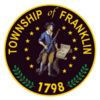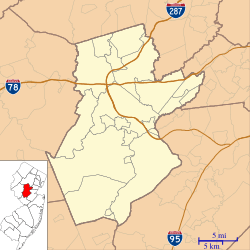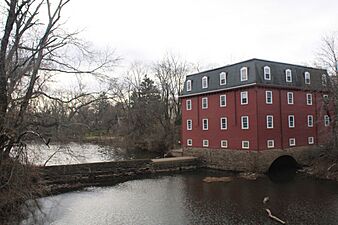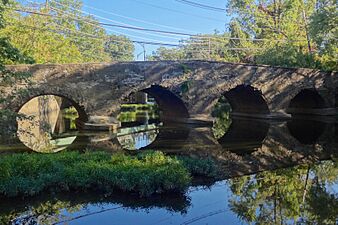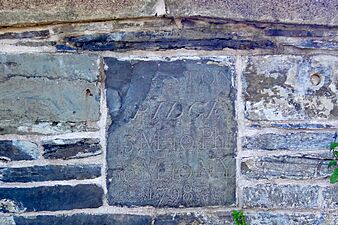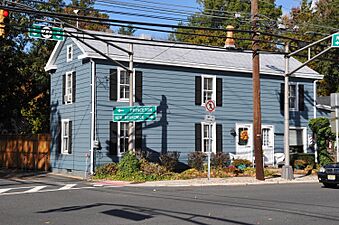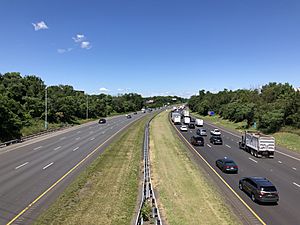Franklin Township, Somerset County, New Jersey facts for kids
Quick facts for kids
Franklin Township, New Jersey
|
||
|---|---|---|
|
Township
|
||
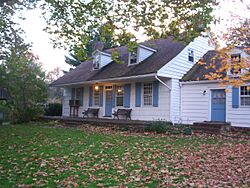
Van Wickle House on Easton Avenue
|
||
|
||

Location of Franklin Township in Somerset County highlighted in yellow (right). Inset map: Location of Somerset County in New Jersey highlighted in black (left).
|
||
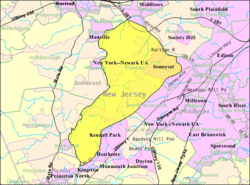
Census Bureau map of Franklin Township, Somerset County, New Jersey
|
||
| Country | ||
| State | ||
| County | Somerset | |
| Formed as Eastern precinct | c. 1745 | |
| Incorporated | February 21, 1798 | |
| Named for | Benjamin Franklin | |
| Government | ||
| • Type | Faulkner Act (council–manager) | |
| • Body | Township Council | |
| Area | ||
| • Total | 46.88 sq mi (121.43 km2) | |
| • Land | 46.17 sq mi (119.58 km2) | |
| • Water | 0.71 sq mi (1.85 km2) 1.52% | |
| Area rank | 37th of 565 in state 2nd of 21 in county |
|
| Elevation | 62 ft (19 m) | |
| Population
(2020)
|
||
| • Total | 68,364 | |
| • Estimate
(2023)
|
68,233 | |
| • Rank | 19th of 565 in state 1st of 21 in county |
|
| • Density | 1,480.7/sq mi (571.7/km2) | |
| • Density rank | 337th of 565 in state 8th of 21 in county |
|
| Time zone | UTC−05:00 (Eastern (EST)) | |
| • Summer (DST) | UTC−04:00 (Eastern (EDT)) | |
| ZIP Codes |
08873, 08875 – Somerset (also used as East Millstone)
08528 – Kingston 08823 – Franklin Park 08540 – Princeton 08890 – Zarephath |
|
| Area code(s) | 732, 908 and 609 | |
| FIPS code | 3403524900 | |
| GNIS feature ID | 0882170 | |
Franklin Township is a town in Somerset County, New Jersey. It's located in the middle of the Raritan Valley area, close to New York City. In 2020, about 68,364 people lived here. This was a jump of over 6,000 people since 2010. Franklin Township was the 19th most populated town in New Jersey in 2020.
Long ago, Franklin Township was mostly farms. Today, it's a fast-growing suburb with many new buildings. It's a place where people from different backgrounds, religions, and cultures live together. In 2008, Money magazine even called Franklin Township one of America's Top 100 Best Places to Live!
The area was first called Eastern precinct around 1745. Franklin Township officially became a town on February 21, 1798. Some parts of the township later became separate towns, like South Bound Brook and East Millstone. However, East Millstone later rejoined Franklin Township.
Contents
History of Franklin Township
It's not totally clear if Franklin Township was named after Benjamin Franklin, a famous founding father, or his son, William Franklin. William was the last Royal Governor of New Jersey before the American Revolution. In 2000, after looking at different historical facts, the Township Council decided that the town was indeed named after Benjamin Franklin.
Revolutionary War Events
Franklin Township played a part in the American Revolutionary War. Many small battles and raids happened along what is now Route 27, which was then called the King's Highway. British generals tried to get George Washington and his army to fight on the open fields of Middlebush and East Millstone. But Washington wisely kept his troops safe until the British left. British soldiers destroyed several farms in Middlebush as they retreated.
In 1777, near the Millstone River in Weston, American soldiers and local fighters successfully pushed back about 600 British troops. These British soldiers were looking for food and supplies. On November 2, 1783, George Washington wrote his farewell message to the army while staying at Rockingham, a house near Rocky Hill.
Canals and Railroads
The building of the Delaware and Raritan Canal in the 1830s brought a lot of growth to Franklin Township. This canal was 22 miles long and connected New York City and Philadelphia. By the 1860s, over 200,000 tons of goods were shipped on barges using the canal. Later, when railroads became popular for shipping goods, the canal was used less. Today, this area is part of the beautiful Delaware and Raritan Canal State Park.
The Van Wickle House, built in 1722 by Dutch settlers, is located next to the Delaware and Raritan Canal. It's now owned by Franklin Township and managed by the Meadows Foundation. This historic home is near the Rutgers Preparatory School and an old graveyard from the Revolutionary War era.
Railroad service also came to Franklin Township in the mid-1800s. The Millstone and New Brunswick Railroad opened in 1854, connecting New Brunswick to East Millstone. Parts of this old railroad line are still used today for local industries.
Geography and Communities
Franklin Township covers about 46.88 square miles. Most of the township, about 75%, is still rural with open spaces.
Neighboring Towns
Franklin Township shares borders with several other towns. These include Bridgewater, Hillsborough, Manville, Millstone, Montgomery, Rocky Hill, and South Bound Brook in Somerset County. It also borders Princeton in Mercer County, and New Brunswick, North Brunswick, Piscataway, and South Brunswick in Middlesex County.
Local Communities
Franklin Township is made up of many smaller communities and areas. Some of these include:
- Blackwells Mills
- Clyde
- East Franklin
- East Millstone
- East Rocky Hill
- Franklin Center
- Franklin Park
- Griggstown
- Kingston – This area is special because it's advised by a committee from both Franklin and South Brunswick townships.
- Middlebush
- Pleasant Plains
- Six Mile Run
- Somerset
- Ten Mile Run
- Voorhees
- Weston
- Zarephath – This is a religious community centered around the Pillar of Fire Church.
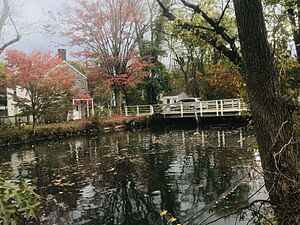
Population and People
Franklin Township has grown a lot over the years. In 1790, about 2,068 people lived here. By 2020, the population had grown to 68,364.
A Diverse Community
Franklin Township is known for its diverse population. People from many different backgrounds live here. In 2020, the community included:
- About 31% White residents
- About 24% Black or African American residents
- About 23% Asian residents
- About 17% Hispanic or Latino residents (who can be of any race)
This mix of cultures and backgrounds makes Franklin Township a vibrant place to live.
Parks and Outdoor Fun
Franklin Township has many great parks and places to enjoy nature.
- William L. Hutcheson Memorial Forest is a 500-acre nature preserve managed by Rutgers University. It has a 65-acre old-growth forest, which is a very old forest that has not been cut down. It's a special place to see nature as it was long ago.
- Colonial Park is a large park with 685.5 acres. You can enjoy picnics, hiking, biking, fishing, paddle boating, golf, and tennis here. The park has a "living tree museum" called an Arboretum, with many types of trees and shrubs. There's also a dog park, a fitness trail, and beautiful gardens like the Rose Garden.
- Delaware and Raritan Canal State Park runs along the northern and western edges of Franklin Township. This park is 22 miles long and offers hiking, biking, fishing, and boating. You can find places to park and access the canal at many points, including near Colonial Park and the Van Wickle House.
- John W. Flemer Preserve is a 7.4-acre preserve next to the Delaware and Raritan Canal in Kingston. It has a 2-mile trail that connects to the canal's tow path, making it great for a round trip hike.
- Negri-Nepote Native Grassland Preserve is a 164-acre preserve with grasslands, forests, and wetlands. It's a great spot for birdwatching and has over 3 miles of trails.
- Six Mile Run Reservoir Site is a 3,037-acre park with many trails for walking, biking, and other activities. It's a largely undeveloped area perfect for exploring nature.
- Ten Mile Run Greenway is a 684-acre greenway that stretches over 4 miles. It includes several sections:
- Bunker Hill Natural Area has trails through forests and meadows.
- Catalpa Farm offers trails along fields and a small forest.
- Environmental Education Center is a 95-acre area with a forest, a nature trail, and a "Glass House" used for learning about nature. It also has a climbing tower and ropes course.
- Griggstown Native Grassland Preserve has over 100 acres of grassland and hundreds of acres of forest with over 6 miles of mapped trails.
Education in Franklin Township
The Franklin Township Public Schools serve students from pre-kindergarten all the way through 12th grade. The district has 10 schools and teaches over 7,000 students.
Schools in the District
- Claremont Elementary School (Pre-K–5)
- Conerly Road School (Pre-K–5)
- Elizabeth Avenue School (Pre-K–5)
- Franklin Park School (Pre-K–5)
- Hillcrest School (Pre-K–5)
- MacAfee Road School (Pre-K–5)
- Pine Grove Manor School (Pre-K–5)
- Franklin Middle School at Hamilton Street Campus (6–8)
- Franklin Middle School at Sampson G. Smith Campus (6–8)
- Franklin High School (9–12)
Other Schools
- Central Jersey College Prep Charter School is a public charter school for grades 6–12. It helps students get ready for a four-year university. In 2016, it was named a National Blue Ribbon School, which is a high honor.
- Rutgers Preparatory School is a private school founded in 1766, making it the oldest independent school in the state. It moved to Franklin Township in 1957.
- Saint Matthias School is a private Catholic elementary school for preschool through 8th grade.
- Cedar Hill Preparatory School is a private Pre-K–8 school. In 2017, it was also recognized as an Exemplary High Performing School by the National Blue Ribbon Schools Program.
Historic Places to Visit
Franklin Township has several historic places that tell stories of the past.
- The Kingston Mill Historic District is a historic area that includes the community of Kingston. The current Kingston Mill, also known as the Kingston Gristmill, was built in 1888. It's located on the Millstone River along the old King's Highway. This area is important for its history in engineering, settlement, industry, and transportation.
-
Kingston Mill on the Millstone River
-
The Kingston Bridge (1798), built to replace one demolished by George Washington's troops to prevent British pursuit
-
The mile marker from 1798, showing the distance to Philadelphia (45 miles) and New York City (50 miles)
- The Blackwells Mills Canal House, built around the 1830s, was home to the bridge tender who opened the swing bridge for canal boats. Today, it's maintained by local foundations.
- The Franklin Inn, built around 1752, was once a farmhouse and later became a hotel.
- The Hageman Farm, from around 1861, is a historic farm owned by Franklin Township.
- Rockingham State Historic Site is where George Washington wrote his Farewell Address to the Revolutionary Army in 1783.
- Spieden & Hoebel Farms, Little Valley Natural Area offers miles of trails through forests and fields.
- Tulipwood, built around 1892, is a beautiful historic home owned by Franklin Township.
- The Ukrainian Cultural Center is a large site that includes the headquarters of the Ukrainian Orthodox Church of the USA. It has a seminary, a church, a cemetery, and a museum with Ukrainian cultural treasures.
- The historic Fisher Homestead, built in 1688, was the home of Hendrick Fisher, an important figure in New Jersey's history during the American Revolution.
- The Van Liew-Suydam House, built in the 18th century, is another historic farm owned by Franklin Township.
- The Van Wickle House, built around 1722, is a historic house that hosts special events.
- The Wyckoff-Garretson House, built in 1730, has been restored and is managed by the Meadows Foundation.
Getting Around Franklin Township
Roads and Highways
Franklin Township has many miles of roads. Interstate 287 is a major highway that runs through the northern part of the township. Route 27 also runs along the border of the township. Other important county roads include CR 514, CR 518, and CR 527.
Public Transportation
Somerset County offers bus routes that serve Franklin Township, connecting it to places like Bound Brook and New Brunswick. There is also commuter bus service to Midtown Manhattan in New York City during busy times.
Notable People from Franklin Township
Many interesting people have lived in or are connected to Franklin Township. Here are a few:
- Avery Brooks (born 1948), an actor famous for his roles in Star Trek: Deep Space Nine and Spenser: For Hire.
- Clifford P. Case (1904–1982), a politician who served in the U.S. House of Representatives and the U.S. Senate.
- Upendra J. Chivukula (born 1950), a local politician who served as mayor of Franklin Township.
- Margit Feldman (1929–2020), a Holocaust survivor who became a public speaker and educator.
- Hendrick Fisher (1697–1778), an important leader during the American Revolution and a founder of Rutgers University.
- Colonel Routh Goshen (1837–1889), known as the "Middlebush Giant," who was said to be the tallest man in the world.
- Roy Hinson (born 1961), a professional basketball player who played for the Cleveland Cavaliers and other NBA teams.
- John Honeyman (1729–1822), believed to be a spy for George Washington during the Revolutionary War.
- Diamond Miller (born 2001), a talented college basketball player.
- Maleah Joi Moon (born 2003), a Tony Award-winning actress.
- Paul Muldoon (born 1951), a Pulitzer Prize-winning poet.
- Michael James Pappas (born 1960), a former U.S. Congressman and former mayor of Franklin Township.
- Randal Pinkett (born 1971), the winner of The Apprentice 4, an entrepreneur, and a scholar.
- Jeff Porter (born 1985), an Olympic track and field athlete.
- Joe Porter (born 1985), a football player who played in the NFL.
- Charlie Weis (born 1956), a famous football coach who coached at University of Notre Dame.
- Helen Westley (1875–1942), a popular movie actress from the 1930s and 1940s.
- Bruce Williams (1932–2019), a long-running radio talk show host and former mayor of Franklin Township.
See also
 In Spanish: Municipio de Franklin (condado de Somerset) para niños
In Spanish: Municipio de Franklin (condado de Somerset) para niños


